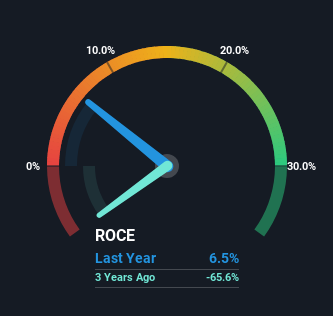Daldrup & Söhne (ETR:4DS) Is Looking To Continue Growing Its Returns On Capital
If we want to find a stock that could multiply over the long term, what are the underlying trends we should look for? One common approach is to try and find a company with returns on capital employed (ROCE) that are increasing, in conjunction with a growing amount of capital employed. If you see this, it typically means it's a company with a great business model and plenty of profitable reinvestment opportunities. So when we looked at Daldrup & Söhne (ETR:4DS) and its trend of ROCE, we really liked what we saw.
Understanding Return On Capital Employed (ROCE)
If you haven't worked with ROCE before, it measures the 'return' (pre-tax profit) a company generates from capital employed in its business. The formula for this calculation on Daldrup & Söhne is:
Return on Capital Employed = Earnings Before Interest and Tax (EBIT) ÷ (Total Assets - Current Liabilities)
0.065 = €1.6m ÷ (€36m - €12m) (Based on the trailing twelve months to June 2023).
Therefore, Daldrup & Söhne has an ROCE of 6.5%. Ultimately, that's a low return and it under-performs the Energy Services industry average of 9.6%.
View our latest analysis for Daldrup & Söhne
In the above chart we have measured Daldrup & Söhne's prior ROCE against its prior performance, but the future is arguably more important. If you're interested, you can view the analysts predictions in our free analyst report for Daldrup & Söhne .
What Can We Tell From Daldrup & Söhne's ROCE Trend?
Daldrup & Söhne has not disappointed in regards to ROCE growth. We found that the returns on capital employed over the last five years have risen by 952%. That's not bad because this tells for every dollar invested (capital employed), the company is increasing the amount earned from that dollar. In regards to capital employed, Daldrup & Söhne appears to been achieving more with less, since the business is using 81% less capital to run its operation. Daldrup & Söhne may be selling some assets so it's worth investigating if the business has plans for future investments to increase returns further still.
On a side note, we noticed that the improvement in ROCE appears to be partly fueled by an increase in current liabilities. The current liabilities has increased to 32% of total assets, so the business is now more funded by the likes of its suppliers or short-term creditors. It's worth keeping an eye on this because as the percentage of current liabilities to total assets increases, some aspects of risk also increase.
The Bottom Line On Daldrup & Söhne's ROCE
In summary, it's great to see that Daldrup & Söhne has been able to turn things around and earn higher returns on lower amounts of capital. Investors may not be impressed by the favorable underlying trends yet because over the last five years the stock has only returned 13% to shareholders. Given that, we'd look further into this stock in case it has more traits that could make it multiply in the long term.
One more thing, we've spotted 2 warning signs facing Daldrup & Söhne that you might find interesting.
While Daldrup & Söhne may not currently earn the highest returns, we've compiled a list of companies that currently earn more than 25% return on equity. Check out this free list here.
Have feedback on this article? Concerned about the content? Get in touch with us directly. Alternatively, email editorial-team (at) simplywallst.com.
This article by Simply Wall St is general in nature. We provide commentary based on historical data and analyst forecasts only using an unbiased methodology and our articles are not intended to be financial advice. It does not constitute a recommendation to buy or sell any stock, and does not take account of your objectives, or your financial situation. We aim to bring you long-term focused analysis driven by fundamental data. Note that our analysis may not factor in the latest price-sensitive company announcements or qualitative material. Simply Wall St has no position in any stocks mentioned.

